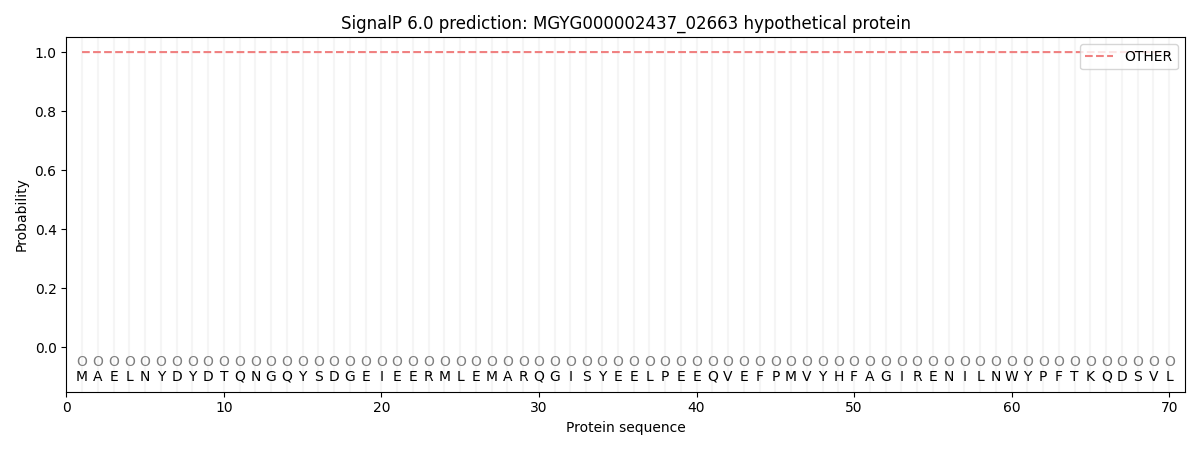You are browsing environment: HUMAN GUT
CAZyme Information: MGYG000002437_02663
You are here: Home > Sequence: MGYG000002437_02663
Basic Information |
Genomic context |
Full Sequence |
Enzyme annotations |
CAZy signature domains |
CDD domains |
CAZyme hits |
PDB hits |
Swiss-Prot hits |
SignalP and Lipop annotations |
TMHMM annotations
Basic Information help
| Species | Blautia hominis | |||||||||||
|---|---|---|---|---|---|---|---|---|---|---|---|---|
| Lineage | Bacteria; Firmicutes_A; Clostridia; Lachnospirales; Lachnospiraceae; Blautia; Blautia hominis | |||||||||||
| CAZyme ID | MGYG000002437_02663 | |||||||||||
| CAZy Family | GT2 | |||||||||||
| CAZyme Description | hypothetical protein | |||||||||||
| CAZyme Property |
|
|||||||||||
| Genome Property |
|
|||||||||||
| Gene Location | Start: 650179; End: 655758 Strand: + | |||||||||||
CAZyme Signature Domains help
| Family | Start | End | Evalue | family coverage |
|---|---|---|---|---|
| GT2 | 886 | 1057 | 2.6e-18 | 0.9823529411764705 |
CDD Domains download full data without filtering help
| Cdd ID | Domain | E-Value | qStart | qEnd | sStart | sEnd | Domain Description |
|---|---|---|---|---|---|---|---|
| cd04186 | GT_2_like_c | 3.14e-30 | 887 | 1099 | 1 | 166 | Subfamily of Glycosyltransferase Family GT2 of unknown function. GT-2 includes diverse families of glycosyltransferases with a common GT-A type structural fold, which has two tightly associated beta/alpha/beta domains that tend to form a continuous central sheet of at least eight beta-strands. These are enzymes that catalyze the transfer of sugar moieties from activated donor molecules to specific acceptor molecules, forming glycosidic bonds. Glycosyltransferases have been classified into more than 90 distinct sequence based families. |
| cd03794 | GT4_WbuB-like | 2.16e-23 | 1589 | 1848 | 122 | 385 | Escherichia coli WbuB and similar proteins. This family is most closely related to the GT1 family of glycosyltransferases. WbuB in E. coli is involved in the biosynthesis of the O26 O-antigen. It has been proposed to function as an N-acetyl-L-fucosamine (L-FucNAc) transferase. |
| COG1216 | GT2 | 1.33e-21 | 887 | 1102 | 7 | 224 | Glycosyltransferase, GT2 family [Carbohydrate transport and metabolism]. |
| pfam00535 | Glycos_transf_2 | 4.04e-18 | 886 | 1055 | 1 | 164 | Glycosyl transferase family 2. Diverse family, transferring sugar from UDP-glucose, UDP-N-acetyl- galactosamine, GDP-mannose or CDP-abequose, to a range of substrates including cellulose, dolichol phosphate and teichoic acids. |
| cd03801 | GT4_PimA-like | 1.08e-17 | 1519 | 1857 | 1 | 365 | phosphatidyl-myo-inositol mannosyltransferase. This family is most closely related to the GT4 family of glycosyltransferases and named after PimA in Propionibacterium freudenreichii, which is involved in the biosynthesis of phosphatidyl-myo-inositol mannosides (PIM) which are early precursors in the biosynthesis of lipomannans (LM) and lipoarabinomannans (LAM), and catalyzes the addition of a mannosyl residue from GDP-D-mannose (GDP-Man) to the position 2 of the carrier lipid phosphatidyl-myo-inositol (PI) to generate a phosphatidyl-myo-inositol bearing an alpha-1,2-linked mannose residue (PIM1). Glycosyltransferases catalyze the transfer of sugar moieties from activated donor molecules to specific acceptor molecules, forming glycosidic bonds. The acceptor molecule can be a lipid, a protein, a heterocyclic compound, or another carbohydrate residue. This group of glycosyltransferases is most closely related to the previously defined glycosyltransferase family 1 (GT1). The members of this family may transfer UDP, ADP, GDP, or CMP linked sugars. The diverse enzymatic activities among members of this family reflect a wide range of biological functions. The protein structure available for this family has the GTB topology, one of the two protein topologies observed for nucleotide-sugar-dependent glycosyltransferases. GTB proteins have distinct N- and C- terminal domains each containing a typical Rossmann fold. The two domains have high structural homology despite minimal sequence homology. The large cleft that separates the two domains includes the catalytic center and permits a high degree of flexibility. The members of this family are found mainly in certain bacteria and archaea. |
CAZyme Hits help
| Hit ID | E-Value | Query Start | Query End | Hit Start | Hit End |
|---|---|---|---|---|---|
| QCU01345.1 | 0.0 | 1 | 1858 | 1 | 1872 |
| QNM10216.1 | 0.0 | 1 | 1858 | 1 | 1859 |
| CBL21588.1 | 0.0 | 1 | 1364 | 1 | 1379 |
| BBK78212.1 | 5.48e-224 | 739 | 1507 | 8 | 789 |
| QMW89726.1 | 5.48e-224 | 739 | 1507 | 8 | 789 |
Swiss-Prot Hits download full data without filtering help
| Hit ID | E-Value | Query Start | Query End | Hit Start | Hit End | Description |
|---|---|---|---|---|---|---|
| Q2LSQ6 | 8.99e-07 | 52 | 129 | 28 | 101 | Ribosomal RNA small subunit methyltransferase A OS=Syntrophus aciditrophicus (strain SB) OX=56780 GN=rsmA PE=3 SV=1 |
| B9DN09 | 5.56e-06 | 57 | 170 | 35 | 139 | Uncharacterized methyltransferase Sca_1399 OS=Staphylococcus carnosus (strain TM300) OX=396513 GN=Sca_1399 PE=3 SV=1 |
| Q8PU18 | 6.32e-06 | 51 | 143 | 24 | 113 | Probable ribosomal RNA small subunit methyltransferase A OS=Methanosarcina mazei (strain ATCC BAA-159 / DSM 3647 / Goe1 / Go1 / JCM 11833 / OCM 88) OX=192952 GN=rsmA PE=3 SV=2 |
| A7G9I5 | 6.54e-06 | 52 | 135 | 27 | 106 | Ribosomal RNA small subunit methyltransferase A OS=Clostridium botulinum (strain Langeland / NCTC 10281 / Type F) OX=441772 GN=rsmA PE=3 SV=1 |
| D5DIV9 | 8.66e-06 | 63 | 171 | 41 | 143 | Malonyl-[acyl-carrier protein] O-methyltransferase OS=Priestia megaterium (strain DSM 319 / IMG 1521) OX=592022 GN=bioC PE=3 SV=1 |
SignalP and Lipop Annotations help
This protein is predicted as OTHER

| Other | SP_Sec_SPI | LIPO_Sec_SPII | TAT_Tat_SPI | TATLIP_Sec_SPII | PILIN_Sec_SPIII |
|---|---|---|---|---|---|
| 1.000062 | 0.000001 | 0.000000 | 0.000000 | 0.000000 | 0.000000 |
